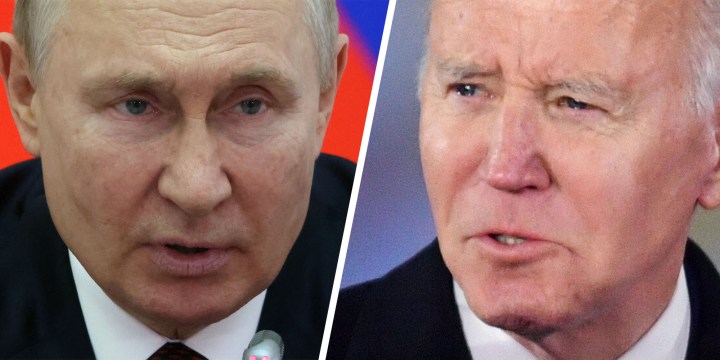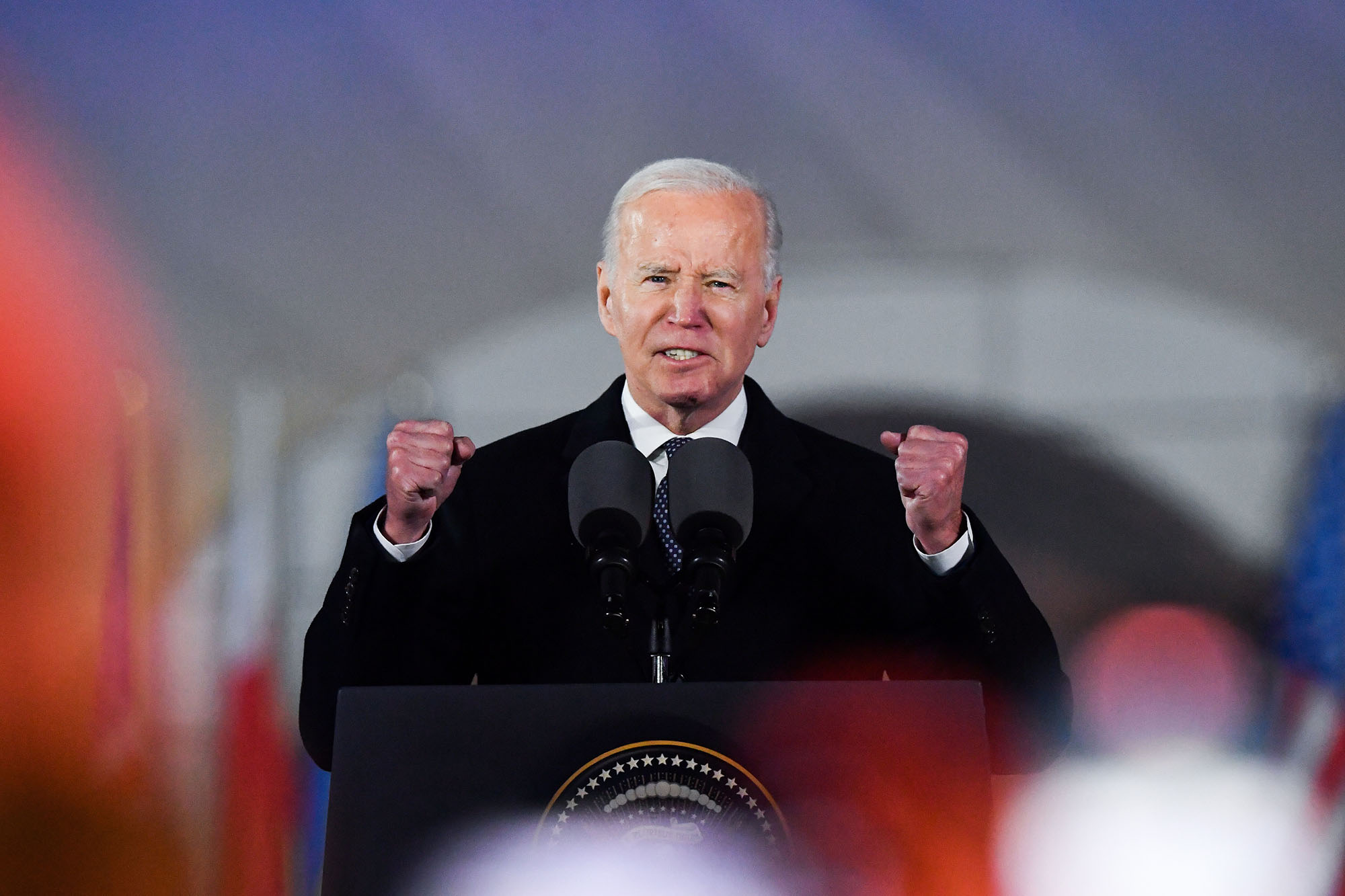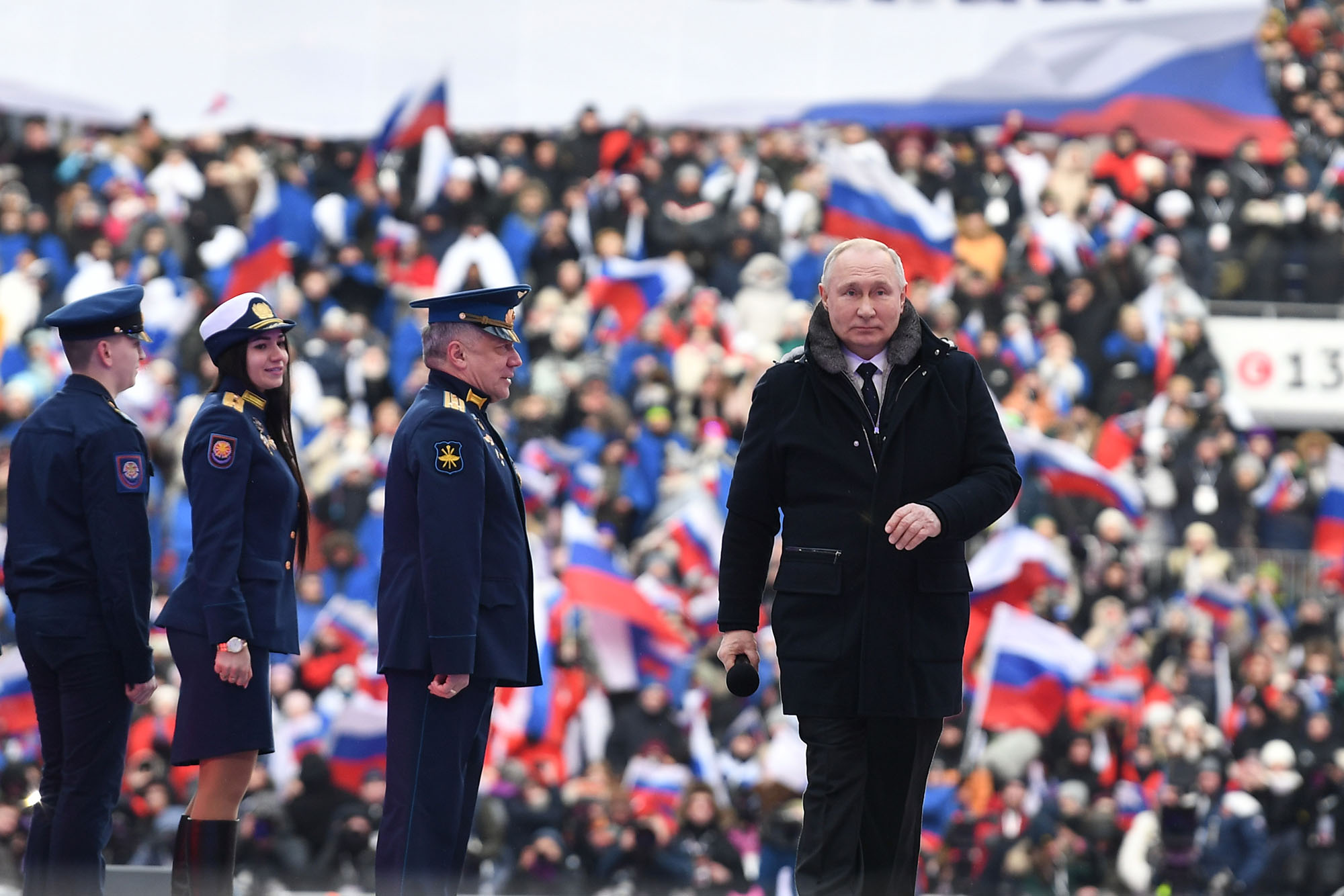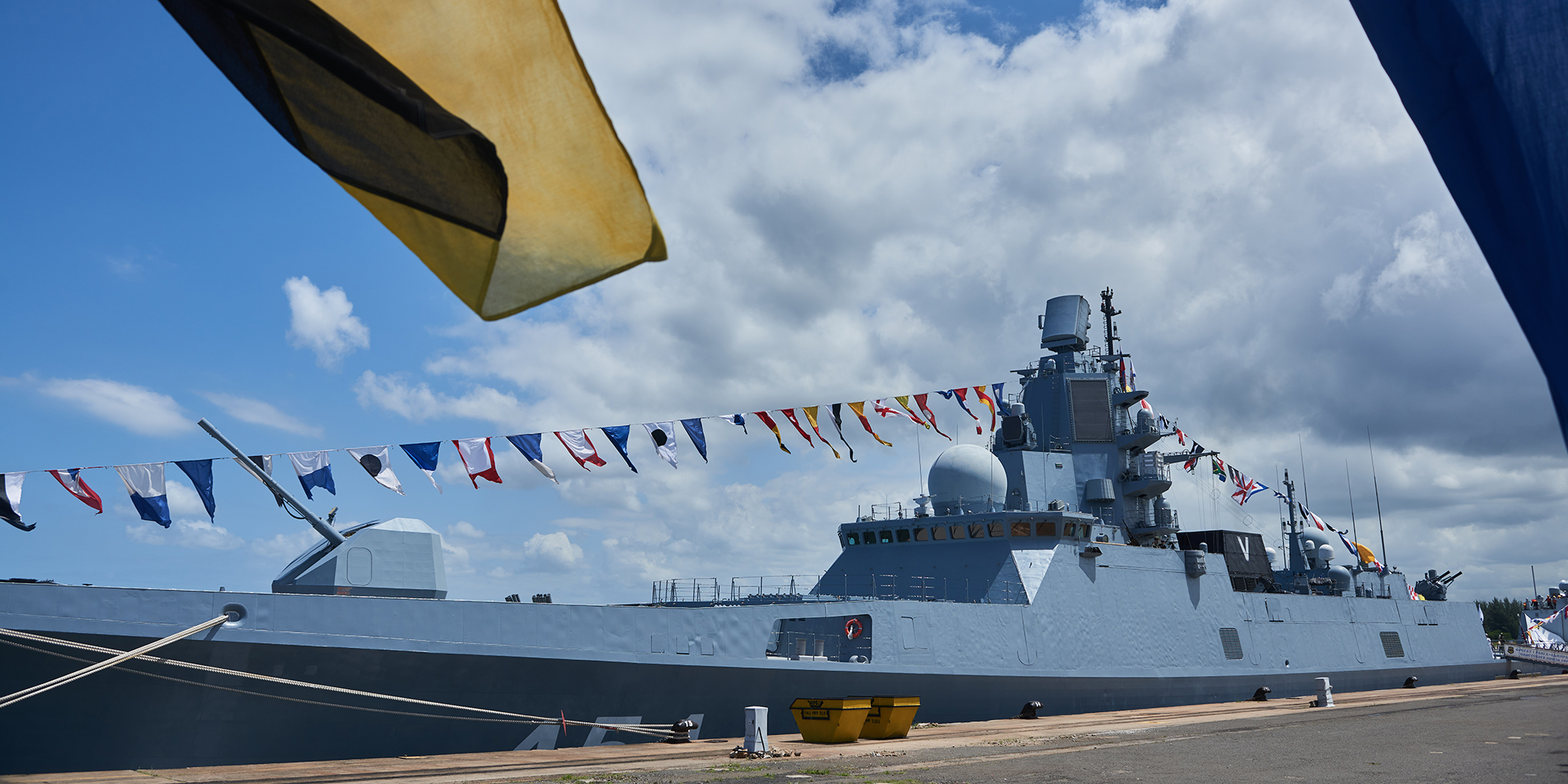WAR IN EUROPE
Biden and Putin — alternate views of Russian invasion as grim anniversary dawns

Two speeches from two different leaders, in different nations — the first anniversary of Russia’s invasion of Ukraine is now upon us.
On 21 February, two presidents, Joe Biden and Vladimir Putin, delivered their respective speeches in two different cities, just a few days in advance of the anniversary of the Russian invasion of its neighbour, Ukraine, that began on 24 February 2022.
Biden, for his spirited speech, was in Warsaw, Poland, after a flying (actually, 10-hour rail) visit to Kyiv to meet with Ukraine’s embattled president.

US President Joe Biden delivers a speech at the Kubicki Arcades, in the back gardens of the Royal Castle, in Warsaw, Poland, 21 February 2023. (Photo: EPA-EFE / Piotr Nowak)
Biden was in Kyiv to offer a dramatic bolstering of his pledge of some deep pockets of military and economic support for that country’s resistance to Russia’s invasion.
In addition, his presence strolling in St Michael’s Square with his Ukrainian opposite number, even as the air raid sirens wailed, provided welcome symbolic support to that beleaguered nation. Then, following a public speech in Warsaw, Biden also met with Nato allies from Eastern Europe to solidify support for Ukraine.
Putin’s tired tropes
By contrast, over on the other side of the metaphorical split screen, there was Russian president Vladimir Putin in Moscow, speaking in front of a captive audience of military officers, parliamentarians and national and regional officials.
Read more in Daily Maverick: “Putin delivers a nuclear warning to the West over Ukraine”
He spouted his tired conspiracies and misinformation about that evil, colossal Western plot to destroy Russia by suckering it into attacking the illegitimate, western cat’s-paw of a diabolical, neo-Nazi Ukraine (before such horrible forces dismembered Russia, just as Western invasions have tried to do for hundreds of years).
The invasion was supposed to forestall the very disaster that his invasion, ironically, may eventually produce. His audience looked on impassively, except when they rose up to offer their scheduled spontaneous applause.
It was a curiously grim event to those who were watching it on television. It was certainly not a victory party. That was supposed to happen almost a year ago when Russian tanks would have already been mopping up any remaining resistance in Kyiv, by then declaring victory over those neo-Nazis, and installing a quisling regime for any of the remaining parts of the country not granted a faux independence in the east or an enlarged Crimea in the south.

Russian President Vladimir Putin attends a rally-concert titled ‘Glory to defenders of the Fatherland’ dedicated to the Defender of the Fatherland Day at Luzhniki Stadium in Moscow, Russia, 22 February 2023. (Photo: EPA-EFE / Maim Blinov / Sputnik)
In the hours after Putin’s speech, there was also a big music event, equipped with light shows, fireworks, mass singing, bands, flag-waving, and adoring, gleaming faces in the crowd (at least if you watched the video feed). This was the usual stuff populist autocrats love. At least we were spared having to hear a rendition of “God Save the Czar,” so that was something.
Reportedly, there was also going to be the gloating announcement of the successful test-firing of a Satan-II mega-MIRVed missile capable of destroying whole nations, but that apparently exploded on or near the launching pad on take-off, so there was no glorious announcement of that. Sometimes things go like that.
Nothing to cheer
Meanwhile, the Putin-ordered bread-and-circuses-style event had obviously been planned with the simulacrum of some sort of modest victory to celebrate in mind; or, at the very least, to mark the whisper of a coming victory and an effort to ensure Russians were enthusiastic about their special military operation.
However, there has actually been very little to cheer about in this war. After a year of increasingly brutal combat, the Russian military has lost many hundreds of tanks and other armoured vehicles, many thousands of troops, and a vast expenditure of other equipment. The Wagner Group and the Russian military are starting to bicker over who is really doing the hard fighting.
The annihilation of Russia’s tank column’s attack towards Kyiv reminded this author of a 21st-century version of how British General Braddock’s regiment was slaughtered by the French and their Amerindian allies in the Seven Years’ War on the colonial American frontier. (Read “Last of the Mohicans” or watch the film for a vivid description of that disaster.)
More ominously still for Russia, on two other fronts, their attacks towards Kharkiv and Kherson were eventually repulsed as the Ukrainian military regained significant territory, leaving the main tool for Russian attacks the use of missiles, drone craft and long-range artillery to attack cities and civilian infrastructure.
Revitalised western alliance
Now, of course, after a year of this invasion, besides unifying the Ukrainian nation, the results include a real sense of and concrete action by a notably less fractious western alliance, as more and more top-tier military hardware is coming Ukraine’s way.
Some military experts now say the military mismatch between combatants is increasingly being minimised by this flow, and that the key difficulties and challenges for the Ukrainians are coming, more and more, from integrating the various new weapons systems (such as the diverse range of tanks, for example) into one coherent military capable of being an effective force carrying out western-style combined arms military doctrine.
A second issue for Ukrainians is how the western nations can build a robust supply and maintenance backroom for all this weaponry, amid the battlefield and back on through the western nations.
One key issue that remains is whether more long-range style weaponry such as F-16 fighter-bomber aircraft can, or should be, supplied to Ukraine. Some worry such transfers would serve as a real provocation to the Russians to move up the escalatory ladder, or expand the geography of its attacks on to neighbouring states.
Global divide
Meanwhile, as far as the western nations are concerned, even as the growing economic and financial sanctions regime on Russia (besides making it more difficult for the economy as a whole) is generating some increasingly real bottlenecks in military production, a key challenge is coming from the possibilities that China may agree to supply needed military supplies to Russia, in addition to buying its petroleum and natural gas (at bargain prices, of course).
Moreover, there remains the continuing problem of convincing the so-called Global South that Ukraine’s fight is their fight as well, even as the war has sharply affected vital grain supplies, of which Ukraine has been a major supplier to many of those Global South nations.
As the Washington Post reported on 23 February, “The conflict has exposed a deep global divide, and the limits of U.S. influence over a rapidly shifting world order. Evidence abounds that the effort to isolate Putin has failed, and not just among Russian allies that could be expected to back Moscow, such as China and Iran.
“India announced last week that its trade with Russia has grown by 400 percent since the invasion. In just the past six weeks, Russian Foreign Minister Sergei Lavrov has been welcomed in nine countries in Africa and the Middle East — including South Africa, whose foreign minister, Naledi Pandor, hailed their meeting as ‘wonderful’ and called South Africa and Russia ‘friends’.”
Mosi II naval exercise
For the West, it remains a hard slog to convince some nations about the war’s origins and its impacts. And that, of course, brings us to South Africa’s mind-boggling decision to host a tripartite naval exercise with Russia and China on the very day of the anniversary of the start of the Russian invasion, one year ago.

Russian frigate Admiral Gorshkov in Richards Bay, northern Kwazulu-Natal, on 22 February 2023. (Photo: Waldo Swiegers / Bloomberg via Getty Images)
While some nations may applaud this effort, it is unclear what, exactly, the South African government hopes to gain from this, beyond some unwavering love and affection from Vladimir Putin. As it turns out, South Africa will not even get a chance to see the much-hyped launch of a Russian hypersonic missile, the vaunted aircraft carrier killer. Just a handful of ships doing anti-piracy drills and some gunnery exercises. Yawn.
Beyond China, South Africa’s trade and investment largely comes from the EU and the US, and Russia’s contribution is virtually a rounding error in international economic statistics. The survey data says a majority of South Africans support Ukraine, and by overwhelming numbers, South Africans say that if they had to or chose to emigrate, they would not pick Russia or China.
Visit Daily Maverick’s home page for more news, analysis and investigations
As a cautionary note, the former Russian foreign minister Andrei Kozyrev (now someone less than welcome back home) said in an interview in El Pais a few months after the war had already begun, “Well, that was difficult. We made mistakes, our government made mistakes, I personally made some mistakes, Americans made mistakes, Europeans too… It’s a complicated story, much more complicated than one simple thing.
“There are some ill-informed people who blame Nato for its so-called expansion, which is just the wrong terminology. It was not a Nato expansion; it was new democracies free from Soviet domination like Czech Republic, Poland, Hungary, even Romania, who knocked on Nato doors and demanded to be members of the Alliance.”
Such advice was obviously not heeded, nor was the understanding that sovereign states make their choices based on national interest, as with Ukraine’s desire to join the EU (if not Nato).
One thing is certain, as the war drags on into its second year, South Africa will almost certainly find itself being forced to take a side publicly, and admit its faux neutrality has been less than productive or useful, even as a potential mediator. (That role may yet fall to China.)
But make no mistake, there will be consequences for a choice in which South Africa aligns itself with a nation whose fabric is increasingly coming unravelled, by virtue of its prosecution of a war it may well not win. And the consequences of that — for Russia — remain very hard to predict. DM



 Become an Insider
Become an Insider
Comments - Please login in order to comment.